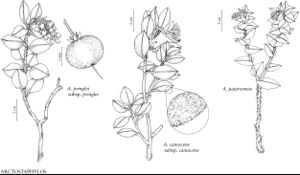Arctostaphylos canescens
Proc. Calif. Acad. Sci., ser. 3, 1: 84. 1897 ,.
Shrubs, erect, 0.3–3 m; burl absent; twigs densely short soft-hairy to white-tomentose. Leaves: petiole 3–10 mm; blade whitish gray, dull, orbiculate-ovate, ovate, or elliptic, 2–5 × 1–3 cm, base rounded to cuneate, margins entire, plane, surfaces smooth, gray-canescent, glabrescent. Inflorescences panicles, 1–3-branched, immature inflorescence pendent, (branches crowded, bell-shaped, ± obscured by bracts), axis 1–2 cm, 1+ mm diam., densely short soft-hairy to white-tomentose; bracts not appressed, (spreading), leaflike, wide-lanceolate, 6–20 mm, apex acute, surfaces canescent. Pedicels 5–9 mm, hairy, sometimes glandular. Flowers: corolla white to pink, conic to urceolate; ovary densely white-hairy, sometimes glandular. Fruits depressed-globose, 5–10 mm diam., sparsely hairy or glabrous, sometimes sparsely glandular. Stones distinct.
Distribution

w United States.
Discussion
Subspecies 2 (2 in the flora).
Arctostaphylos canescens is widespread in the Coast Ranges of central and northern California and northward into southwestern Oregon.
Selected References
None.
Key
| 1 | Twigs, inflorescence axes, pedicels, and fruits eglandular. | Arctostaphylos canescens subsp. canescens |
| 1 | Twigs, inflorescence axes, pedicels, and fruits glandular-hairy. | Arctostaphylos canescens subsp. sonomensis |
